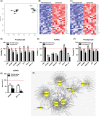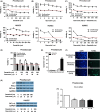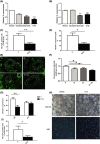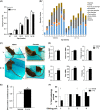The Achilles' heel of senescent cells: from transcriptome to senolytic drugs
- PMID: 25754370
- PMCID: PMC4531078
- DOI: 10.1111/acel.12344
The Achilles' heel of senescent cells: from transcriptome to senolytic drugs
Abstract
The healthspan of mice is enhanced by killing senescent cells using a transgenic suicide gene. Achieving the same using small molecules would have a tremendous impact on quality of life and the burden of age-related chronic diseases. Here, we describe the rationale for identification and validation of a new class of drugs termed senolytics, which selectively kill senescent cells. By transcript analysis, we discovered increased expression of pro-survival networks in senescent cells, consistent with their established resistance to apoptosis. Using siRNA to silence expression of key nodes of this network, including ephrins (EFNB1 or 3), PI3Kδ, p21, BCL-xL, or plasminogen-activated inhibitor-2, killed senescent cells, but not proliferating or quiescent, differentiated cells. Drugs targeting these same factors selectively killed senescent cells. Dasatinib eliminated senescent human fat cell progenitors, while quercetin was more effective against senescent human endothelial cells and mouse BM-MSCs. The combination of dasatinib and quercetin was effective in eliminating senescent MEFs. In vivo, this combination reduced senescent cell burden in chronologically aged, radiation-exposed, and progeroid Ercc1(-/Δ) mice. In old mice, cardiac function and carotid vascular reactivity were improved 5 days after a single dose. Following irradiation of one limb in mice, a single dose led to improved exercise capacity for at least 7 months following drug treatment. Periodic drug administration extended healthspan in Ercc1(-/∆) mice, delaying age-related symptoms and pathology, osteoporosis, and loss of intervertebral disk proteoglycans. These results demonstrate the feasibility of selectively ablating senescent cells and the efficacy of senolytics for alleviating symptoms of frailty and extending healthspan.
Keywords: PI3K delta; dasatinib; dependence receptors; ephrins; p21; plasminogen-activated inhibitor; quercetin.
© 2015 The Authors. Aging Cell published by the Anatomical Society and John Wiley & Sons Ltd.
Figures






Similar articles
-
Identification of a novel senolytic agent, navitoclax, targeting the Bcl-2 family of anti-apoptotic factors.Aging Cell. 2016 Jun;15(3):428-35. doi: 10.1111/acel.12445. Epub 2016 Mar 18. Aging Cell. 2016. PMID: 26711051 Free PMC article.
-
Senolytics decrease senescent cells in humans: Preliminary report from a clinical trial of Dasatinib plus Quercetin in individuals with diabetic kidney disease.EBioMedicine. 2019 Sep;47:446-456. doi: 10.1016/j.ebiom.2019.08.069. Epub 2019 Sep 18. EBioMedicine. 2019. PMID: 31542391 Free PMC article.
-
Identification of HSP90 inhibitors as a novel class of senolytics.Nat Commun. 2017 Sep 4;8(1):422. doi: 10.1038/s41467-017-00314-z. Nat Commun. 2017. PMID: 28871086 Free PMC article.
-
A study of the molecular mechanism of quercetin and dasatinib combination as senolytic in alleviating age-related and kidney diseases.J Food Biochem. 2022 Dec;46(12):e14471. doi: 10.1111/jfbc.14471. Epub 2022 Oct 21. J Food Biochem. 2022. PMID: 36268851 Review.
-
Hsp90 inhibitors as senolytic drugs to extend healthy aging.Cell Cycle. 2018;17(9):1048-1055. doi: 10.1080/15384101.2018.1475828. Epub 2018 Jul 23. Cell Cycle. 2018. PMID: 29886783 Free PMC article. Review.
Cited by
-
[A Review of Celluar Senescence and Tumor Treatment].Sichuan Da Xue Xue Bao Yi Xue Ban. 2021 Mar;52(2):176-181. doi: 10.12182/20210360503. Sichuan Da Xue Xue Bao Yi Xue Ban. 2021. PMID: 33829688 Free PMC article. Review. Chinese.
-
Early onset senescence and cognitive impairment in a murine model of repeated mTBI.Acta Neuropathol Commun. 2021 May 8;9(1):82. doi: 10.1186/s40478-021-01190-x. Acta Neuropathol Commun. 2021. PMID: 33964983 Free PMC article.
-
Senescent cell death brings hopes to life.Cell Cycle. 2017 Jan 2;16(1):9-10. doi: 10.1080/15384101.2016.1232088. Epub 2016 Sep 16. Cell Cycle. 2017. PMID: 27636703 Free PMC article. No abstract available.
-
Therapeutic targeting of cellular senescence in diabetic macular edema: preclinical and phase 1 trial results.Nat Med. 2024 Feb;30(2):443-454. doi: 10.1038/s41591-024-02802-4. Epub 2024 Feb 6. Nat Med. 2024. PMID: 38321220 Clinical Trial.
-
Stem Cells of the Aging Brain.Front Aging Neurosci. 2020 Aug 6;12:247. doi: 10.3389/fnagi.2020.00247. eCollection 2020. Front Aging Neurosci. 2020. PMID: 32848716 Free PMC article. Review.
References
-
- Ajay M, Achike FI, Mustafa AM, Mustafa MR. Direct effects of quercetin on impaired reactivity of spontaneously hypertensive rat aortae: comparative study with ascorbic acid. Clin. Exp. Pharmacol. Physiol. 2006;33:345–350. - PubMed
-
- Boyd AW, Bartlett PF, Lackmann M. Therapeutic targeting of EPH receptors and their ligands. Nature reviews. Drug Discov. 2014;13:39–62. - PubMed
-
- Breccia M, Molica M, Alimena G. How tyrosine kinase inhibitors impair metabolism and endocrine system function: a systematic updated review. Leuk. Res. 2014;38:1392–1398. - PubMed
Publication types
MeSH terms
Substances
Grants and funding
- AG044396/AG/NIA NIH HHS/United States
- R01 DK057993/DK/NIDDK NIH HHS/United States
- AG041122/AG/NIA NIH HHS/United States
- F30 AG046061/AG/NIA NIH HHS/United States
- P30 AG013319/AG/NIA NIH HHS/United States
- AG031736/AG/NIA NIH HHS/United States
- UL1-TR000157/TR/NCATS NIH HHS/United States
- P01 AG041122/AG/NIA NIH HHS/United States
- HL111121/HL/NHLBI NIH HHS/United States
- P30 DK084567/DK/NIDDK NIH HHS/United States
- AG013925/AG/NIA NIH HHS/United States
- R01 HL111121/HL/NHLBI NIH HHS/United States
- DK050456/DK/NIDDK NIH HHS/United States
- AG043376/AG/NIA NIH HHS/United States
- P01 AG043376/AG/NIA NIH HHS/United States
LinkOut - more resources
Full Text Sources
Other Literature Sources
Medical
Molecular Biology Databases
Research Materials

